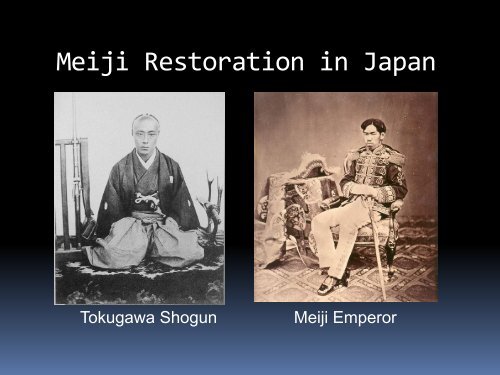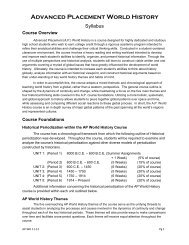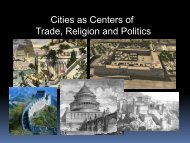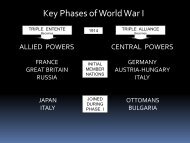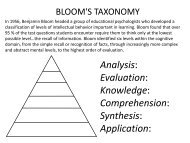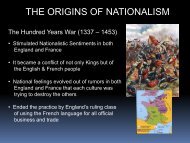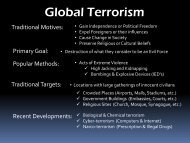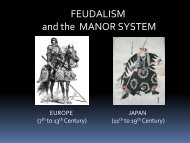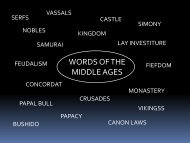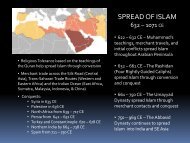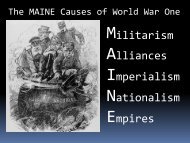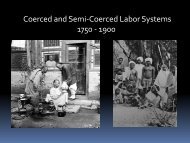The Meiji Restoration
The Meiji Restoration
The Meiji Restoration
You also want an ePaper? Increase the reach of your titles
YUMPU automatically turns print PDFs into web optimized ePapers that Google loves.
<strong>Meiji</strong> <strong>Restoration</strong> in Japan<br />
Tokugawa Shogun <strong>Meiji</strong> Emperor
<strong>Meiji</strong> <strong>Restoration</strong>: Lead-up<br />
“Edo Period”<br />
• Tokugawa Family ruled Japan from 1603 – 1868<br />
• Emperor reigned over Japan under Tokugawa protection<br />
• Foreign trade limited to China, Korea, and Netherlands<br />
at Nagasaki a few times each year<br />
• Japanese Feudalism with power held by Daimyos and<br />
the Samurai Warrior class<br />
• Internal Trade dominated as Merchant class became<br />
wealthier than the upper class Daimyo / Samurai
<strong>Meiji</strong> <strong>Restoration</strong>: Lead-up<br />
“Initial Western Influences”<br />
• “Rangaku” or “Dutch Learning”<br />
became popular with doctors,<br />
scientists and scholars<br />
• New knowledge and technology<br />
benefitted entrepreneurs in<br />
Trade and Industry<br />
• Went against Japanese traditions<br />
and threatened the power of<br />
Daimyo’s and Samurai
<strong>Meiji</strong> <strong>Restoration</strong>: Lead-up<br />
“U.S. Influences”<br />
U.S. Commodore Matthew C. Perry<br />
• 1853: Gunboat Diplomacy<br />
• 1854: Treaty of Kanagawa<br />
Consul General Townsend Harris<br />
• 1856: First Consulate to Japan<br />
• 1858: Harris Treaty opens Trade
<strong>Meiji</strong> <strong>Restoration</strong>: Lead-up<br />
“Anglo-Japanese Conflict”<br />
1862 - 1863<br />
• Choshu Incident: Western ships<br />
fired on by Choshu Samurai<br />
• Bombardment of Kagoshima:<br />
British Royal Navy fired on Port City<br />
1862<br />
• Namamugi Incident:<br />
British merchants<br />
attacked by Satsuma<br />
Samurai in Namamugi
<strong>Meiji</strong> <strong>Restoration</strong>: Lead-up<br />
“Satsuma-Choshu Alliance”<br />
• Dissatisfaction with new<br />
Tokugawa policies allowing<br />
foreigners more access to Japan<br />
• 1866: Alliance between the<br />
Satsuma and Choshu Provinces<br />
against the Tokugawa Shogunate<br />
• 1867 – 1869: Boshin War<br />
(Satsuma-Choshu alliance<br />
versus the Tokugawa Shogun)<br />
• Each side accepted military<br />
training, supplies and<br />
support from western allies
<strong>Meiji</strong> <strong>Restoration</strong>: Lead-up<br />
“Why the Satsuma and Choshu?”<br />
• Two richest Han clans in Japan<br />
• Choshu: 100 + years of illegal,<br />
secret investment in commercial<br />
enterprises<br />
• Satsuma: Controlled highly profitable sugar monopoly<br />
• Both: Secretly and illegally traded with Western nations<br />
for technology and military equipment
Young Emperor <strong>Meiji</strong><br />
<strong>Meiji</strong> <strong>Restoration</strong><br />
1868<br />
• Declare <strong>Restoration</strong> of the<br />
Emperor to his rightful place<br />
Liberate the Emperor from<br />
Tokugawa’s rule<br />
Emperor to rule directly<br />
• Emperor issued a decree<br />
ending the rule of the<br />
Tokugawa Shogunate<br />
• Tokugawa Yoshinobu stepped<br />
down from power
New <strong>Meiji</strong> Leadership by 1870’s<br />
• Collective leadership with the Emperor<br />
• 20-30 young leaders<br />
Mostly samurai<br />
Mostly from Satsuma or Choshu<br />
Includes some reformers among the royal court<br />
• Known as the <strong>Meiji</strong> Oligarchy<br />
• Key Goals:<br />
Westernize<br />
Modernize<br />
Industrialize<br />
Militarize<br />
Become an Imperial Power
<strong>Meiji</strong> Plans for Reform<br />
• 1871 Iwakura Mission to the West:<br />
Analyze Western Governments<br />
Improve Western Contacts<br />
Create new Alliances<br />
• Key Government Ideas Adopted:<br />
1872: Sovereign Monarch (Like Germany)<br />
1889: Legislative Branch (Like German Diet)<br />
1890: Independent Cabinet (Like the U.S.)<br />
1890: Emperor Grants Constitution<br />
1890’s: Elite Bureaucracy (Similar to France)
<strong>Meiji</strong> Plans for Reform<br />
• Key Economic Reforms Adopted:<br />
Abolish Feudalism and Institute Land Reform<br />
Adopt National Currency (Yen) in 1872<br />
Encourage Foreign Trade<br />
Expand Industrialization<br />
Businesses patterned after British & US<br />
• Key Military Reforms Adopted:<br />
Elimination of Local Samurai Armies<br />
Creation of Modern Army (Like the Prussians)<br />
Creation of Modern Navy (Like the British)<br />
Accept Military Equipment and Training from the West<br />
1873 Conscription Act to require every male to serve<br />
3 years in the military
<strong>Meiji</strong> Japan Expands<br />
• First Sino-Japanese War (1894 – 1895):<br />
Gained control of Formosa (Taiwan)<br />
Gained control of Manchuria (N. China)<br />
Gained influence over Korean Peninsula<br />
Treaty of Shimonoseki (17 April 1895)<br />
• Russo-Japanese War (1904-1905):<br />
Destruction of Russian Fleet<br />
Re-confirmed control of Manchuria<br />
Established Japan as a World Power<br />
Formal Control established in Korea<br />
Treaty of Portsmouth (5 September 1905)<br />
• Annexation of Korea (1910):


